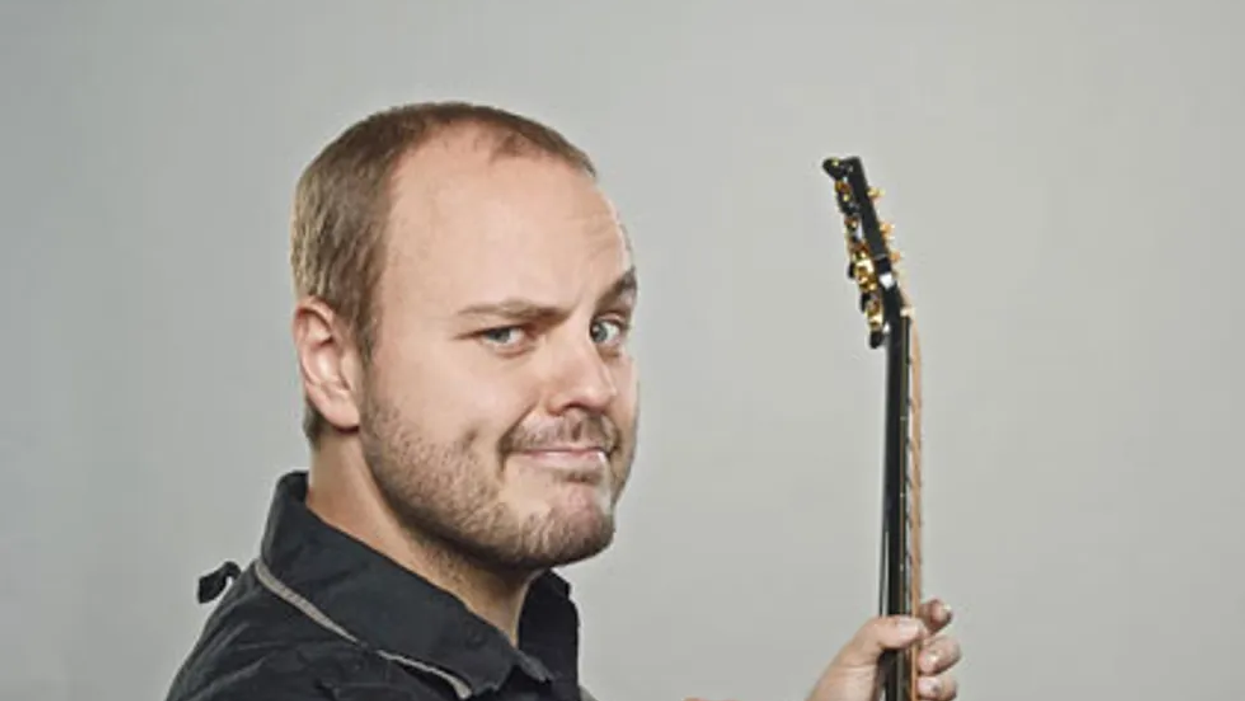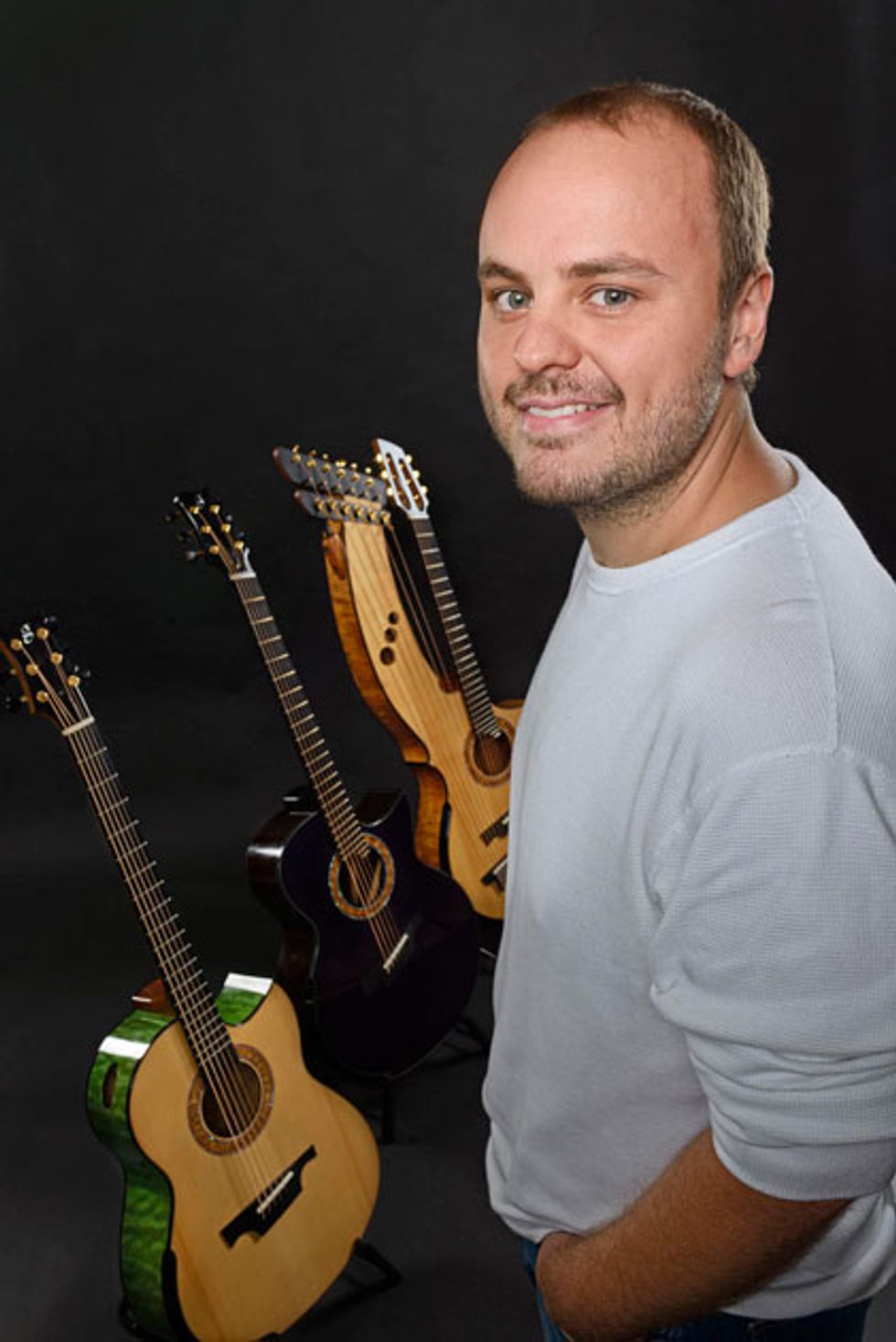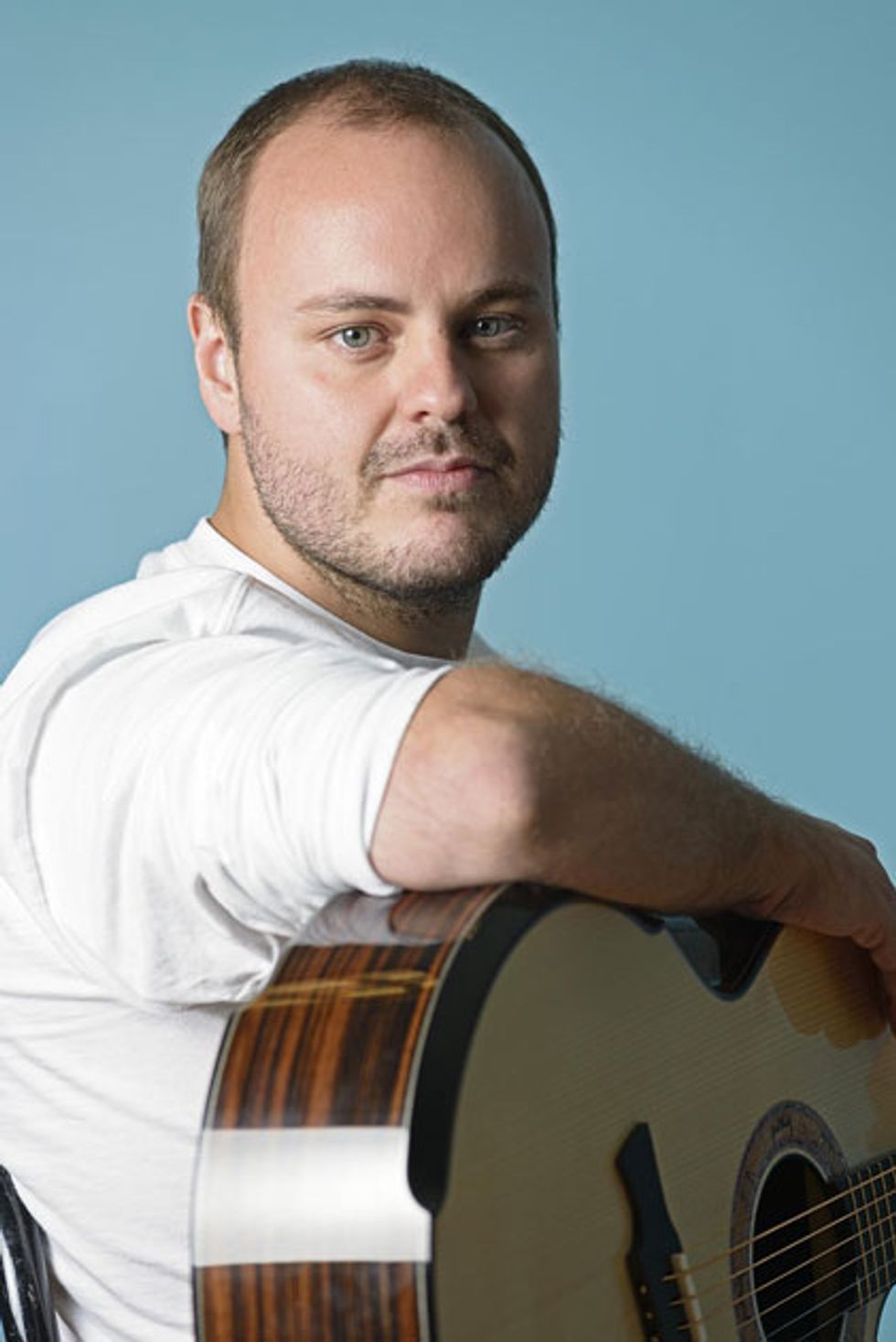It has been nearly a decade since Andy McKee's video for “Drifting" turned the former guitar teacher from Topeka, Kansas, into one of YouTube's first viral music stars. Millions of views and a spate of critically acclaimed albums followed, but it's McKee's ability as a live performer—one who can pull orchestral sound out of a single guitar—that has kept him on the road almost constantly.
Until last year, that is, when he finally unpacked his bags and found time to produce a long-awaited follow-up to 2010's Joyland. The result is the four-song EP, Mythmaker, the first release on his new Mythmaker imprint. While the collection showcases McKee's trademark two-handed acoustic technique, there are also a couple of surprises in store for longtime fans, including his first foray into recording electric guitar and even a solo piano piece. We caught up with McKee as he was getting ready to hit the road yet again with a tour that will kick off in China before returning to North America.
It has been four years since you released an album. Why the wait?
I've found it hard to write music when I'm touring. In 2013 I decided to take some time off to finish writing some tunes. On the road, I'll come up with some new chord progressions or riffs, and maybe a bit of a melodic idea, and use my iPhone to record them. I've been doing that for the last two or three years, so when I actually had time in the studio, I could review all those ideas and try to develop them—see where else I could take them. The two solo guitar tunes [“The Reason" and “Mythmaker"] were developed from riffs I came up with on the road.
Also, whenever I write, I have to put the songs down and come back. It's usually a matter of really thinking about the tunes and taking time away from the instrument. It can be a bit of a time-consuming process.
Do you hear something in your head and try to figure out how to execute it? Or do you get an idea while playing and start to develop that?
It's usually the latter. Using altered tunings helps me to get more creative with the guitar and try different things. I'll start to hear melodic ideas that will work with whatever sort of riff I'm coming up with. But sometimes I'll hear an idea without even having the guitar in my hand, so then it's just a matter of finding it on the fretboard.
How many different tunings do you use?
I don't know for sure. But almost all my songs are in a different tuning, though I've got a few I've used for multiple songs. If I were to take a guess, it would probably be around 20 to 30 different tunings so far.
What's your process for developing a tuning?
I have a few different ways. One example is a song called “Art of Motion." I'd found this really great chord voicing in standard tuning—an F#m11—but it had a really big stretch. I've got really small fingers and hands, so I thought, “Maybe I can find all these intervals and put them into an open tuning."
Sometimes I'll make a variation on a more common tuning—like DADGAD—and just experiment with it. Put an F# and an E in there so I end up with a major ninth. Other times, it's totally by accident—the tuning for “Blue Liquid," for example. Whenever I travel overseas, I always detune the guitar and take the tension off the neck. I got to my hotel one time and opened the case, and it was in this really cool tuning. I thought, “Oh, maybe I can use this."
How do you keep track of them all?
Before I start recording, I'll play all the open notes. But I also tried to work on my ear when I was starting out. It was hard to find sheet music back then for guys like Michael Hedges or many of my other favorite guitar players, so I would listen closely for open strings and harmonics and try to figure out the tuning that way.
“I didn't go direct out of the acoustic guitars this time—I thought using mics offered a bit more natural sound."
Let's talk about some of the songs on the new EP. How did “The Reason" come together?
I really wanted to focus more on melody, not so much on flashy guitar techniques. That tune was really inspired by my two sons. It has two distinct parts: It starts with the nice melodic part, where you've got a new baby. Then they grow up a bit and you get to play with them. For the second, more playful part, I wanted to go with a Travis picking kind of thing. It's in an open Emaj9 tuning: E–B–D#–F#–B–D#.
That song has a lot of textures.
I mentioned Michael Hedges earlier, and I'm going to mention him again now. I was really inspired by him and one of the main things I picked up was the idea of texture—how you can attack strings differently to get different sounds.
not so much on flashy guitar techniques."
In “The Reason," there's a point where I hammer on a note and then I pluck the note, and then pull off to the same note. The tonal characteristic of a note that's hammered is quite different from one that's plucked, or if the plucked string is fretted or open—they all have different textures.
Right up there with texture is dynamics, and the way you can control that. I really started to think about dynamics after doing a lot of performances. One time, there was a table near the front of the stage and the people were talking a lot. So I thought, “How can I get them to be a bit quieter so everyone can appreciate the show more?" I decided to just play softly and look at them for a bit and they got the hint. That was when it first struck me how dynamics can really affect the mood and the way everybody's experiencing the music.
Your guitar sounds big and natural. How did you record it?
All the acoustic guitars on
Mythmaker were recorded the same way. I've got a studio at home, and I recorded and engineered everything myself. I had a small-diaphragm Lauten Audio ST-221 Torch condenser microphone near the guitar, and a large-diaphragm Mojavi Audio MA-200 condenser more in the room for some ambience.
Andy McKee's Gear
Guitars
Greenfield G4.2
Greenfield HG1.2 harp guitar
Greenfield G4B.2 baritone
Greenfield G2B baritone
Music Man LIII
Music Man John Petrucci BFR7 7-string
Amps
D-TAR Solstice preamp
Shure GLXD14 wireless system
Effects
None
Strings and Picks
Ernie Ball Aluminum Bronze medium (.013–.056)
Ernie Ball M-Steel Regular Slinky (.010–.046)
Shubb S1 and S5 capos
Dunlop Jazz III Sharp 1.38 mm picks
Both mics ran through an Apogee Duet preamp. I just used those two signals and that was it. I didn't go direct out of the acoustic guitars this time—I thought using mics offered a bit more natural sound.
How about “Mythmaker"?
That's on the baritone guitar, which is tuned from low to high: A–E–A–B–E–G#. So that's like an Amaj9. I came up with a couple of the parts over the years, and it was just a matter of gluing them together. With this EP, I was trying to let creativity take me where it might and not feel too boxed in by being a solo acoustic guitar player. I wanted to have a tune that was dedicated to the creative spirit. It's got a kind of funky, aggressive quality, but at the end there's a turnaround that builds into this majestic thing. I wanted to build the energy in a unique way. I slap harmonics on every other beat to create a driving element at the end of the song that leads into a finale that's a little more chilled. Then it concludes with a harmonic ending that's suspended and leaves you hanging.
Speaking of harmonics: Is it challenging to get them right all the time? Or is it second nature for you by now?
It's still challenging sometimes. It's practice and repetition, and getting comfortable with the angles you're using to play slap harmonics, or pinch harmonics, artificial harmonics—all different kinds.
What inspired you to add piano and electric guitar to “Lumine"?
I started on electric, playing rock and heavy metal, before switching to acoustic and getting into open tunings when I was about 16. I love solo acoustic guitar and I'm sure I'll do it forever, but I've always been into a lot of different kinds of music. So I wanted to experiment a little bit more and try some different things, which included electric guitar.
“Lumine" started out with just solo acoustic guitar parts. For the chorus, I came up with this really beautiful part on acoustic guitar with harmonics ringing out, but there wasn't really a melodic idea there. I thought piano would be really cool for that. For the bridge, I had the piano and acoustic guitar, and I thought, “Why not? I think it could use an electric guitar solo in here!" I've always loved really melodic and tasty lead guitar guys like Eric Johnson and Joe Satriani, so I think you might hear some of that inspiration in what I do on electric guitar. I'm really happy with the way it turned out. Maybe in the future I'll do some collaborative things with electric guitar players who I've had the good fortune to meet and who are interested in working together.
“Sometimes I'll hear an idea without even having the guitar in my hand,
so then it's just a matter of finding it on the fretboard," says Andy McKee.
Your acoustic playing is your trademark. How did it feel to introduce your electric side?
It was kind of liberating and fun. It reminded me of when I was younger, and it's a completely different approach for me, just trying to play those nice melodic lines on electric guitar is very different from trying to cover all the bases on an acoustic guitar. You have a bit more control over what you're saying in the melody and how you're expressing it. And you've got the whammy bar and all the different ways you can manipulate the melody.
What guitars did you use on “Lumine" and how did you get the electric sound?
The acoustic guitar is the baritone again, and it's the same one I used for “Mythmaker"—a Greenfield G4B.2. The tuning for the acoustic is G#–E–G#–B–E–B, and there's a capo on the 3rd fret. On the electric, I used a Music Man LIII through a Fender G-DEC practice amp. It's preset 8, if I'm not mistaken, a kind of Eric Johnson sound.
The solo piano piece, “June," was even more of a surprise.
I wrote it just last year. It's dedicated to my maternal grandmother, who sadly passed away before I met her. To be totally clear, sadly, she committed suicide. I was thinking about that subject and my grandmother who I never met, and it's just a sad thing. So it's dedicated to her memory and just the sadness that people can experience. It's unfortunate that people get so depressed or so down that it happens, but that's where it came from.
YouTube It
Andy McKee performs “Mythmaker," the title track off his new EP, and showcases his aggressive acoustic attack on his Greenfield GFB.2.
Do you ever play something on the guitar and try to learn it on the piano, or write something on the piano and try to bring it to the guitar?
I've come up with an idea on piano and put it on the guitar. It's more of an exercise, I guess. Come up with a line on the piano and try it on the guitar—that kind of thing. But my approach on both instruments is the same. I know a fair amount about theory and chord construction and things like that, but when I'm writing, I try to use my ear and let things happen as naturally as I can.
How do you maintain and develop your techniques? Are you still developing new ones?
I don't really try to develop new ideas spontaneously. If a new technique comes up, it's because I'm trying to make something happen that I'm hearing in my head. I definitely learned a lot of different techniques just from listening to guys like Michael Hedges and Don Ross and Preston Reed. I can't really say I'm this great technique pioneer in any way, but I learned a lot from those guys and tried to use those techniques to write the music that I want and the music I hear in my head.
Is a full-length album in the works?
I'm trying to stick to this idea of releasing EPs, like four or five songs, and doing that more frequently, rather than waiting so long to put an album together. We're so used to getting new things so rapidly with the internet. I think getting new music out faster is the most important thing right now.


















![Rig Rundown: Russian Circles’ Mike Sullivan [2025]](https://www.premierguitar.com/media-library/youtube.jpg?id=62303631&width=1245&height=700&quality=70&coordinates=0%2C0%2C0%2C0)








